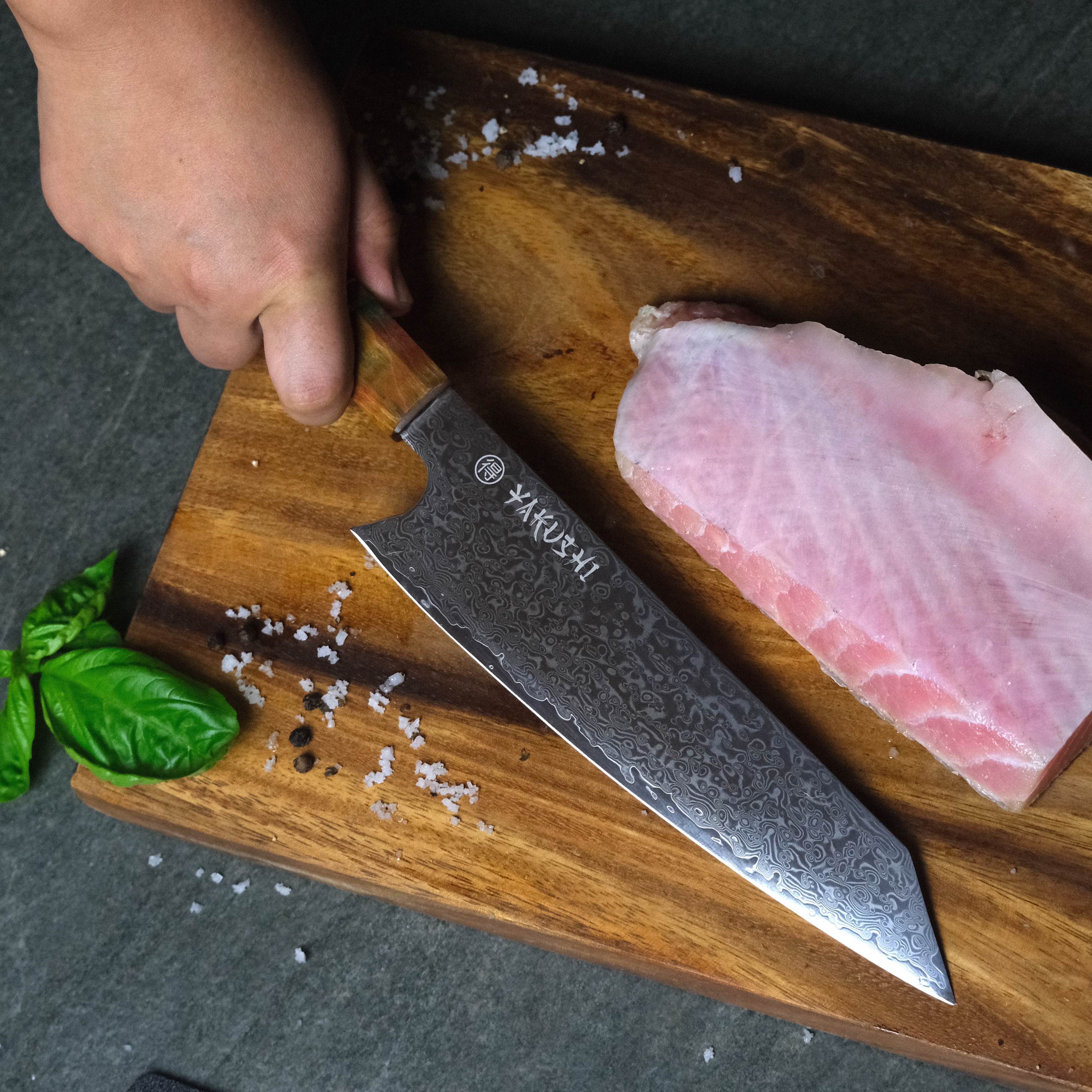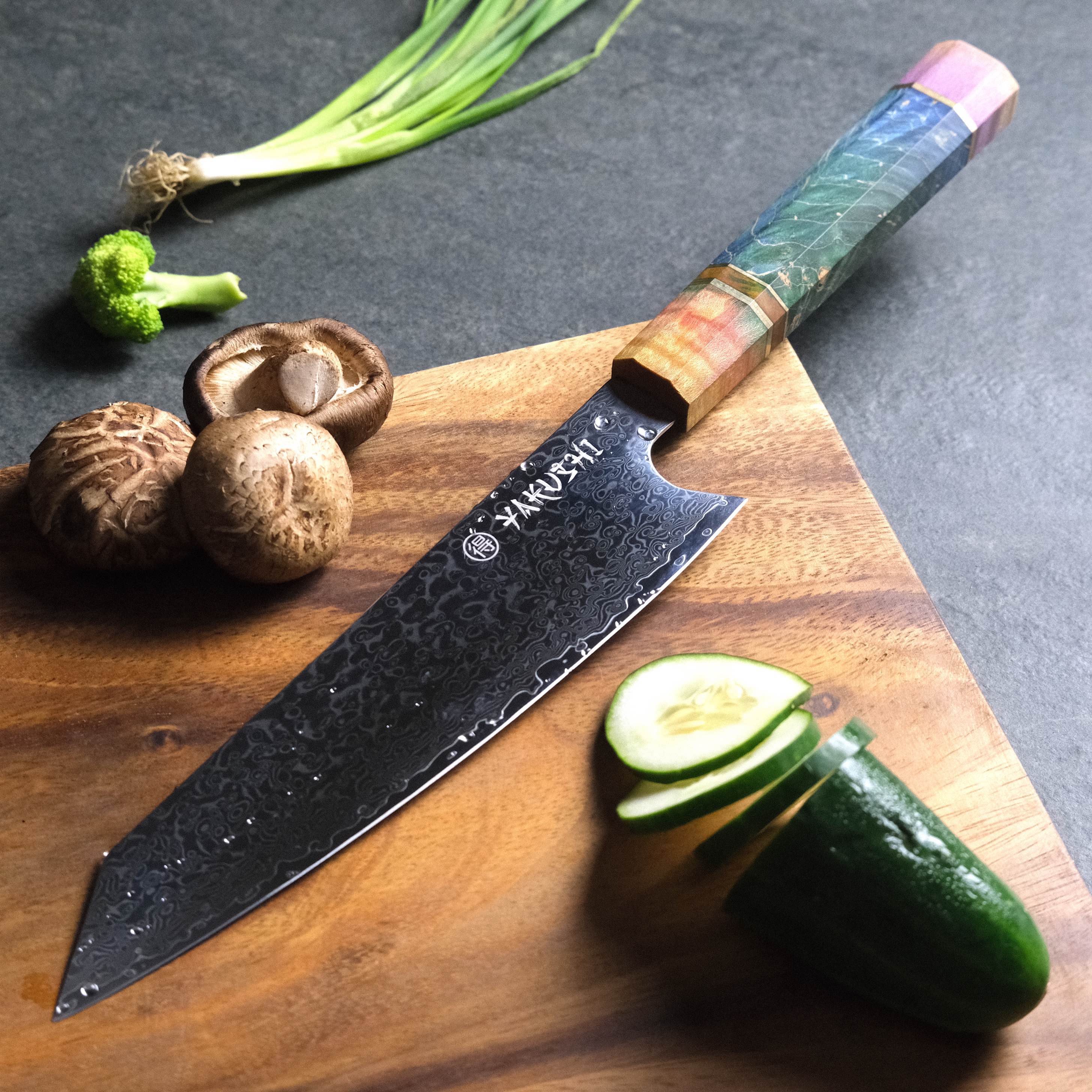What should you Know
About the Japanese Master Chef’s Knife?
A Brief Introduction to Kiritsuke Knives
Cooking is an art, and it calls for the use of cutting-edge tools and innovative methodologies. And when it comes to essential kitchen tools, knives cannot be ignored in any circumstances. Many high-quality knives are available all around the world, and Kiritsuke knives come one of the top-notch ones.
In other words, Kiritsuke knives mark a status symbol in the culinary world due to the learning curve associated with their applications. The level of difficulty needed to grasp the expertise and skills to handle Kiritsuke knives may help convert beginners into experienced cooks.
Did you know Japanese chefs leverage the power of Kiritsuke knives to cut scrumptious fish preparations? In short, Kiritsuke knives are multifaceted blades to create magic in the kitchen in the form of masterpiece recipes.
However, it is a must to choose the best Kiritsuke knife to get the optimum benefits of this kitchen tool. On the other hand, personal tastes and cooking requirements vary from one person to another. That is why you should be clear about your requirements and expectations before choosing the best Kiritsuke knife for your kitchen. It is time to know more about this best-in-class knife to make you realize its significance in your kitchen.

More about Kiritsuke Knives
Kiritsuke Knives witness its applications in diverse Asian-oriented or Japanese cuisines. The style and shape of this multipurpose blade are a combination of the sought-after Yanagi and Gyuto knives. One of the worth-noting facts about Kiritsuke knives is their lengthier size than conventional Gyuto knives. In addition, these knives come with a sharp angled edge just like Yanagi knives.
And this trait has made Kiritsuke knives capable of slicing fish. That is why more and more executive chefs are in support of leveraging the power of Kiritsuke knives to prepare lip-smacking dishes.
You already know that using a Kiritsuke knife with the ace is not a cakewalk. It calls for some sort of expertise and experience to learn the applications of this knife. Needless to say, chefs with the expertise in handling Kiritsuke knives have achieved something significant in their culinary careers. The best Kiritsuke knife can do wonders in the kitchen to encourage chefs to keep innovating incredible dishes.
What do you know about the look of a Kiritsuke Knife?
If we consider the average length, we would find a Kiritsuke knife to have a length of around 240-330mm. The best-in-class chef’s knife can work on vegetables, chicken, fish, and herbs with equal efficiency. A Kiritsuke knife mostly comes as single-beveled, and that is why you can expect a razor-sharp tip from this chef’s knife. However, you can opt for double-beveled options as well, as per your requirements and preferences.
The most unique aspect of a Kiritsuke knife is its resemblance to a well-known Japanese sword- thanks to the knife’s flat heel and clip point edge. These aspects have made this chef’s knife capable of smashing and rocking.
What are the applications of a Kiritsuke Knife?
Did you know a Kiritsuke knife is primarily used to work with ingredients like vegetables and fish? The push/pull attribute has made this chef’s knife capable of making fine slices of ingredients to be used in various innovative and challenging food preparations.
Kiritsuke knives are mostly seen in family-style or sushi restaurants when it comes to preparing julienne-style ingredients. A proficient chef leverages the power of a Kiritsuke knife by using a pinch grip to grasp over the bolster while the other three fingers are there around the knife’s handle.
Thus, it is possible to make the blade keep rocking or getting pulled or pushed. Moreover, lots of experienced western chefs also leverage the edge of the chef’s knife to ensure precise cuts.
What are the best applications of a Kiritsuke knife? In short, a Kiritsuke knife is an ideal kitchen tool to slice fish and cut vegetables to make them ready to be used in cooking. Moreover, a Kiritsuke blade can also work with boneless proteins (like chicken) to create thin slices.
Note that Kiritsuke cannot be an alternative solution to a Gyuto or Chef’s Knife. Hence, you need to leverage the power of a correct knife to make things done with accuracy. In addition, the flat yet long blade is suitable for working with large vegetables. Thus, you can chop the ingredients and make use of them to create your masterpiece.
Owing to the straight edge, a Kiritsuke knife cannot leverage the power of the rock-chopping method. However, a lot of Western Chefs are in favor of using the technique while working with ingredients. Note that you have to make use of a push-cut motion to slice vegetables and a pull-cut motion to work with raw fish to create precise slices.
Key Features of a Kiritsuke Knife
Are you looking to buy the best Kiritsuke knife?
If yes, then checking out the key features of this powerful kitchen tool would help you make an informed decision.

Size Matters a lot
When it comes to the discussion of knives, size matters a lot to users. A single-bevel Kiritsuke knife is a multifaceted kitchen tool to be used to streamline many cooking chores. Did you know a Kiritsuke knife can perform the same tasks as an Usuba or Yanagiba knife does? For instance, a Kiritsuke knife can work with vegetables and cut them into thin slices.
In addition, Kiritsuke knives are available in diverse blade lengths, starting from 240mm, which may go up to 330mm. However, a Kiritsuke knife of 270mm is recommended due to its length to ensure long drawing cuts. For instance, a 270mm Kiritsuke knife can do wonders while slicing fish.
Note that many cooks leverage the power of Yanagiba knives when it comes to slicing fish. However, making use of Kiritsuke knives for the same shows a different level of achievement for chefs. Nonetheless, traditional Kiritsuke knives are taller as compared to Yanagiba ones.
Do you know how to distinguish a traditional Kiritsuke knife from a Kensaki Yanagiba or Kiritsuke Yanagiba knife? If you come across a knife with a slim yet long blade along with an angled edge, then it is more likely to be a Kensaki Yanagiba or Kiritsuke Yanagiba knife, not a traditional Kiritsuke knife.
Moreover, the unique “reverse tanto” edge on a Yanagiba knife is also a worth-noting factor that differentiates between a Yanagiba blade and a Kiritsuke knife.
What about the Shape?
In essence, a Kiritsuke knife comes with a sword-like shape, thanks to its flat yet long blade. The sword shape of a Kiritsuke blade is also bolstered by its angled ‘reverse tanto’ tip as well as a straight edge. A Kiritsuke blade is longer and straighter as compared to an Usuba knife and Yanagiba knife respectively.
Are you familiar with a Kiritsuke Yanagiba or Kensaki Yanagiba knife but not with a standard single-bevel Kiritsuke knife? Note that both of these knives come with a similar set of features. In short, a Kiritsuke knife is a wider and lengthier version of the Kensaki Yanagiba knife. Furthermore, a Kiritsuke knife comes with a flatter edge as compared to a Kiritsuke Yanagiba or Kensaki Yanagiba knife.
What about the heel of a Kiritsuke knife? In short, the heel profile of Kiritsuke is almost flat. That is why a Kiritsuke knife can be substituted with an Usuba knife in this regard. When it comes to a push-cutting strategy, the flat heel of Kiritsuke can do wonders. Hence, you can expect this blade to slice and chop vegetables with the ace.
On the other hand, Kiritsuke’s angled tip works with diverse ingredients and cuts them with excellent precision. On the other hand, the lengthier shape of the blade has made it work through raw fish. A smooth swift pull-cut with a Kiritsuke knife can keep the texture of ingredients intact. It also alleviates the cell damage of the ingredients, which can otherwise alter the flavor or color of the food.
Discussion on Edge
You already know that most Kiritsuke knives come with a single-beveled edge. As a result, these knives are ground only on one side to ensure a cutting edge with outstanding sharpness. The opposite side of the Kiritsuke blade is a bit of a concave shape, and it has ensured an extraordinary non-stick feature for the blade.
Thus, the knife can create thin slices making them easy to remove from the blade. A single-beveled Kiritsuke knife can work with ingredients by touching them a little bit with its cutting edge. That is how ingredients can keep their natural texture, taste, or freshness intact. Needless to say, a single-beveled Kiritsuke knife calls for a significant learning curve to let users get used to the cutting skills to help them use the tool like a pro.
Did you know that left-handed users of Kiritsuke knives mostly pull to the right-hand side while cutting whereas right-handed people are more likely to do it to the left? A worth-noting point here is that the majority of single-beveled knives are designed to be used by right-handed people. However, if you are a left-handed person, then you need to opt for a left-handed option in this regard.
Wrapping Up:
Would you like to take your expertise and experience in the kitchen to the next level? Then, it is time to opt for the best Kiritsuke knife and learn about how to master its skills. Grasping over the usage of a Kiritsuke knife would mark an achievement for you in your cooking journey. Include a best-in-class Kiritsuke knife into your knife collection, and you can expect to become an expert cook with adequate practice, strong determination, and immense patience.



Leave a comment
This site is protected by hCaptcha and the hCaptcha Privacy Policy and Terms of Service apply.